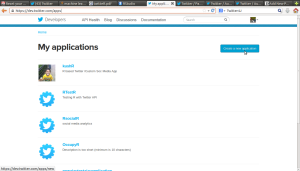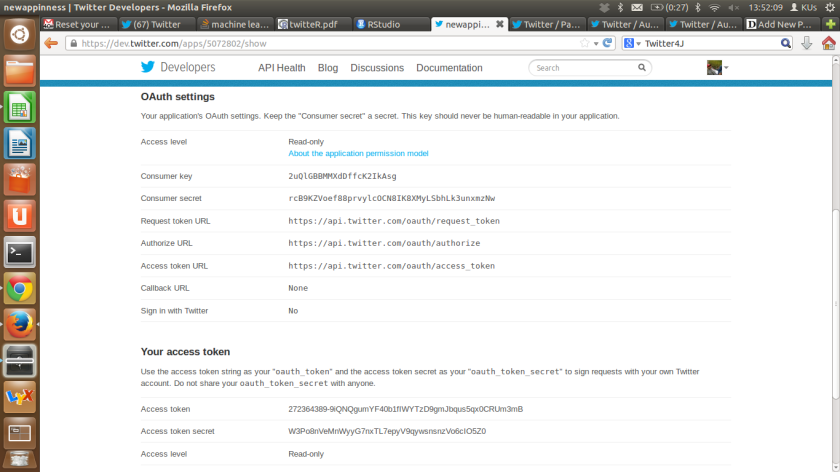Step 1
Install Package twitteR
install.packages("twitteR")
> install.packages("twitteR")
Installing package(s) into ‘/home/R/library’
(as ‘lib’ is unspecified)
also installing the dependencies ‘ROAuth’, ‘rjson’
trying URL 'http://cran.rstudio.com/src/contrib/ROAuth_0.9.3.tar.gz'
Content type 'application/x-gzip' length 6202 bytes
opened URL
==================================================
downloaded 6202 bytes
trying URL 'http://cran.rstudio.com/src/contrib/rjson_0.2.13.tar.gz'
Content type 'application/x-gzip' length 98132 bytes (95 Kb)
opened URL
==================================================
downloaded 95 Kb
trying URL 'http://cran.rstudio.com/src/contrib/twitteR_1.1.7.tar.gz'
Content type 'application/x-gzip' length 121696 bytes (118 Kb)
opened URL
==================================================
downloaded 118 Kb
* installing *source* package ‘ROAuth’ ...
** package ‘ROAuth’ successfully unpacked and MD5 sums checked
** R
** preparing package for lazy loading
** help
*** installing help indices
** building package indices
** testing if installed package can be loaded
* DONE (ROAuth)
* installing *source* package ‘rjson’ ...
** package ‘rjson’ successfully unpacked and MD5 sums checked
** libs
g++ -I/usr/share/R/include -DNDEBUG -fpic -O3 -pipe -g -c dump.cpp -o dump.o
gcc -std=gnu99 -I/usr/share/R/include -DNDEBUG -fpic -O3 -pipe -g -c parser.c -o parser.o
g++ -shared -o rjson.so dump.o parser.o -L/usr/lib/R/lib -lR
installing to /home/R/library/rjson/libs
** R
** inst
** preparing package for lazy loading
** help
*** installing help indices
** building package indices
** installing vignettes
‘json_rpc_server.Rnw’
** testing if installed package can be loaded
* DONE (rjson)
* installing *source* package ‘twitteR’ ...
** package ‘twitteR’ successfully unpacked and MD5 sums checked
** R
** inst
** preparing package for lazy loading
Creating a generic function for ‘as.data.frame’ from package ‘base’ in package ‘twitteR’
** help
*** installing help indices
** building package indices
** testing if installed package can be loaded
* DONE (twitteR)
The downloaded source packages are in
‘/tmp/RtmpvY7yMN/downloaded_packages’
Step 2
Load Package twitteR
library(twitteR) > library(twitteR) Loading required package: ROAuth Loading required package: RCurl Loading required package: bitops Loading required package: digest Loading required package: rjson
Step 3
Using your Twitter Login ID and Password Login to https://dev.twitter.com/apps/
In case you forget the twitter.com username and password, click on Forgot Password to reset Password
Step 4
Create a new app for yourself by navigating to My Applications
Step 5
Your Apps are here
Click on New Application (button on top right)
Step 6
Fill the options here- leave the callback url blank
Name should be Unique
Description should be atleast 10 Charachters
Website can be a placeholder as of now (or your blog address) 
Agree to Terms and Conditions
Type the Spam Check Number and Letters 
Step 7
Note these details from your new APP
Consumer Key
Consumer Secret
On the Bottom –
Click on Create your OAuth Token
Finally your APP page should look like this (dont worry i will be deleting this app so you cant hack my twitter yet)
Step 8
Go to R
Type the following code after you changed the two consumer keys (IMPORTANT- You will need to change your Consumer Key and Consumer Secret to the one specific to YOUR app)
NOTE- WordPress makes some changes when you copy and paste code to your blog
(like adding &8221 to lines 2-4 below- Ignore this please)
THE final formatted code is at very end of the post
library(twitteR)
reqURL <- “https://api.twitter.com/oauth/request_token”
accessURL <- “https://api.twitter.com/oauth/access_token”
authURL <- “https://api.twitter.com/oauth/authorize”
consumerKey <- “2uQlGBBMMXdDffcK2IkAsg”
consumerSecret <- “xrGr71kTfdT3ypWFURGxyJOC4Oqf46Rwu4qxyxoEfM”
twitCred <- OAuthFactory$new(consumerKey=consumerKey,
consumerSecret=consumerSecret,
requestURL=reqURL,
accessURL=accessURL,
authURL=authURL)
Do the Twitter Handshake by pasting this
command in R Console
twitCred$handshake()
You will see a message like this from R
> twitCred$handshake() |
|
|
Step 10
Go to the link above given by R
You will get this message
Authorize app
Step 11 Entering the Pin
Now you see a pin here
like this
 -You cant copy and paste it. Write it down and then type in your R console
-You cant copy and paste it. Write it down and then type in your R console
Step 12
Now register the credentials using
registerTwitterOAuth(twitCred)
you will see this
if done correctly
> registerTwitterOAuth(twitCred) [1] TRUE
Search Twitter using commands like here. Note it returns only 499 tweets
> a=searchTwitter(“#rstats”, n=2000)
Warning message: In doRppAPICall(“search/tweets”, n, params = params, retryOnRateLimit = retryOnRateLimit, : 2000 tweets were requested but the API can only return 499
Step 14 Now you can start analyzing the data
Convert the data into a data frame tweets_df = twListToDF(a)
Install Packages tm (for textmining and wordcloud)
> install.packages(c(“tm”, “wordcloud”))
Load the Packages
library(tm)
library(wordcloud)
Basic Word Cloud can be created using code below
b=Corpus(VectorSource(tweets_df$text), readerControl = list(language = “eng”))
b<- tm_map(b, tolower) #Changes case to lower case
b<- tm_map(b, stripWhitespace) #Strips White Space
b <- tm_map(b, removePunctuation) #Removes Punctuation
inspect(b)
tdm <- TermDocumentMatrix(b)
m1 <- as.matrix(tdm)
v1<- sort(rowSums(m1),decreasing=TRUE)
d1<- data.frame(word = names(v1),freq=v1)
wordcloud(d1$word,d1$freq)
For more detailed analysis on what you can do with Twitter and R, read this http://cran.r-project.org/web/packages/twitteR/twitteR.pdf or this https://sites.google.com/site/miningtwitter/
Step 15 Keep your OAuth keys safely, and do your homework with out bothering your instructor too much.
If you try and copy the paste the code from a website, be sure to change the quotation marks “” manually in your R console
Also see on text mining https://decisionstats.com/2012/03/19/text-mining-barack-obama/
FINAL CODE
install.packages("twitteR") library(twitteR) reqURL <- "https://api.twitter.com/oauth/request_token" accessURL <- "https://api.twitter.com/oauth/access_token" authURL <- "https://api.twitter.com/oauth/authorize" consumerKey <- "rR16FxDLkTYmuVhqH4s4EQ" consumerSecret <- "xrGr71kTfdT3ypWFURGxyJOC4Oqf46Rwu4qxyxoEfM" twitCred <- OAuthFactory$new(consumerKey=consumerKey, consumerSecret=consumerSecret, requestURL=reqURL, accessURL=accessURL, authURL=authURL) twitCred$handshake() #Pause here for the Handshake Pin Code registerTwitterOAuth(twitCred) #Wait till you see True a=searchTwitter("#rstats", n=2000) #Get the Tweets
tweets_df = twListToDF(a) #Convert to Data Frame install.packages(c("tm", "wordcloud")) library(tm) library(wordcloud) b=Corpus(VectorSource(tweets_df$text), readerControl = list(language = "eng")) b<- tm_map(b, tolower) #Changes case to lower case b<- tm_map(b, stripWhitespace) #Strips White Space b <- tm_map(b, removePunctuation) #Removes Punctuation inspect(b) tdm <- TermDocumentMatrix(b) m1 <- as.matrix(tdm) v1<- sort(rowSums(m1),decreasing=TRUE) d1<- data.frame(word = names(v1),freq=v1) wordcloud(d1$word,d1$freq)








Thanks. How can I use R to post my tweets
Nice tutorial, just keep in mind that if running code on windows OS you need the code below.
options(RCurlOptions = list(cainfo = system.file(“CurlSSL”, “cacert.pem”, package = “RCurl”)))
download.file(url=”http://curl.haxx.se/ca/cacert.pem”, destfile=”cacert.pem”)
twitCred$handshake(cainfo=”cacert.pem”)
It still didnt work on Windows
Hi Ajay,
Try changing the url to http instead of https.
There is nice tutorial available here
Click to access DataScienceBookV2.pdf